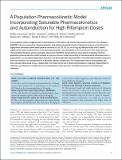Files in this item
A population pharmacokinetic model incorporating saturable pharmacokinetics and autoinduction for high rifampicin doses
Item metadata
| dc.contributor.author | Svensson, Robin J. | |
| dc.contributor.author | Aarnoutse, Rob E. | |
| dc.contributor.author | Diacon, Andreas H | |
| dc.contributor.author | Dawson, Rodney | |
| dc.contributor.author | Gillespie, Stephen H. | |
| dc.contributor.author | Boeree, Martin J. | |
| dc.contributor.author | Simonsson, Ulrika S. H. | |
| dc.date.accessioned | 2017-08-08T10:30:13Z | |
| dc.date.available | 2017-08-08T10:30:13Z | |
| dc.date.issued | 2018-04 | |
| dc.identifier | 250351811 | |
| dc.identifier | 38977a4b-3f44-4e09-828f-aefee6947c90 | |
| dc.identifier | 85043456721 | |
| dc.identifier | 000427114900030 | |
| dc.identifier.citation | Svensson , R J , Aarnoutse , R E , Diacon , A H , Dawson , R , Gillespie , S H , Boeree , M J & Simonsson , U S H 2018 , ' A population pharmacokinetic model incorporating saturable pharmacokinetics and autoinduction for high rifampicin doses ' , Clinical Pharmacology & Therapeutics , vol. 103 , pp. 674-683 . https://doi.org/10.1002/cpt.778 | en |
| dc.identifier.issn | 1532-6535 | |
| dc.identifier.other | Bibtex: urn:a091c4d63187746694d462988d1d5d98 | |
| dc.identifier.other | ORCID: /0000-0001-6537-7712/work/39477858 | |
| dc.identifier.uri | https://hdl.handle.net/10023/11402 | |
| dc.description | The research leading to these results has received funding from the Swedish Research Council in addition to the Innovative Medicines Initiative Joint Undertaking (www.imi.europe.eu) under grant agreement n°115337, resources of which are composed of financial contribution from the European Union’s Seventh Framework Programme (FP7/2007-2013) and EFPIA companies’ in kind contribution. | en |
| dc.description.abstract | Accumulating evidence suggest that increasing doses of rifampicin may shorten tuberculosis treatment. The PanACEA HIGHRIF1 trial assessed safety, pharmacokinetics and anti-mycobacterial activity of rifampicin at doses up to 40 mg/kg. Eighty-three pulmonary tuberculosis patients received 10, 20, 25, 30, 35 or 40 mg/kg rifampicin daily over 2 weeks, supplemented with standard doses of isoniazid, pyrazinamide and ethambutol in the second week. This study aimed at characterizing rifampicin pharmacokinetics observed in HIGHRIF1 using non-linear mixed effects modeling. The final population pharmacokinetic model included an enzyme turn-over model accounting for time-dependent elimination due to auto-induction, concentration-dependent clearance and dose-dependent bioavailability. The relationship between clearance and concentration was characterized by a Michaelis-Menten relationship. The relationship between bioavailability and dose was described using an Emax relationship. The model will be key in determining exposure-response relationships for rifampicin and should be considered when designing future trials and when treating future patients with high dose rifampicin. | |
| dc.format.extent | 10 | |
| dc.format.extent | 1020315 | |
| dc.language.iso | eng | |
| dc.relation.ispartof | Clinical Pharmacology & Therapeutics | en |
| dc.subject | Rifampin | en |
| dc.subject | Tuberculosis | en |
| dc.subject | Pharmacokinetics | en |
| dc.subject | Modeling | en |
| dc.subject | Nonlinear models | en |
| dc.subject | RA0421 Public health. Hygiene. Preventive Medicine | en |
| dc.subject | RM Therapeutics. Pharmacology | en |
| dc.subject | 3rd-DAS | en |
| dc.subject | SDG 3 - Good Health and Well-being | en |
| dc.subject.lcc | RA0421 | en |
| dc.subject.lcc | RM | en |
| dc.title | A population pharmacokinetic model incorporating saturable pharmacokinetics and autoinduction for high rifampicin doses | en |
| dc.type | Journal article | en |
| dc.contributor.institution | University of St Andrews. School of Medicine | en |
| dc.contributor.institution | University of St Andrews. Global Health Implementation Group | en |
| dc.contributor.institution | University of St Andrews. Gillespie Group | en |
| dc.contributor.institution | University of St Andrews. Biomedical Sciences Research Complex | en |
| dc.contributor.institution | University of St Andrews. Infection Group | en |
| dc.contributor.institution | University of St Andrews. Infection and Global Health Division | en |
| dc.identifier.doi | https://doi.org/10.1002/cpt.778 | |
| dc.description.status | Peer reviewed | en |
| dc.identifier.url | http://onlinelibrary.wiley.com/doi/10.1002/cpt.778/full#footer-support-info | en |
This item appears in the following Collection(s)
Items in the St Andrews Research Repository are protected by copyright, with all rights reserved, unless otherwise indicated.

